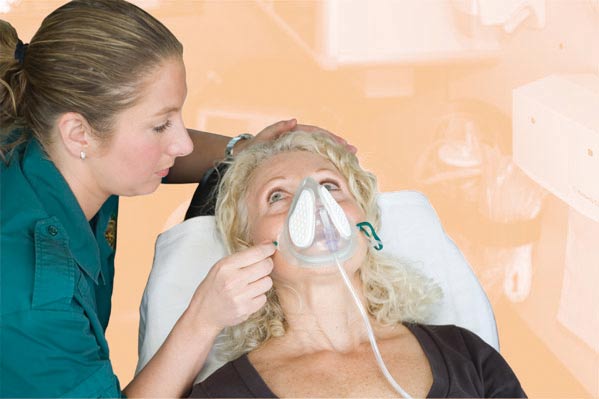
Oxygen is always extolled as the vital essential for life. But it is also a very caustic substance. It has the ability to turn iron into rust and explode fuels into blazing flames. The shocking thing is that this necessity is also harmful to the cells of the human body. Many respiratory problems and other conditions are often treated with a supply of oxygen. The hyperbaric oxygen chamber is recommended too. However, before opting for oxygen therapy, one must be aware that oxygen toxicity is a very real danger. It causes damage to almost all parts of the body – the eyes, the nervous system, the lungs, the reproductive organs and the endocrine glands
Chronic obstructive pulmonary disease complications
Patients that suffer from emphysema and chronic obstructive pulmonary disease are always in the danger of respiratory failure due to accumulation of carbon dioxide in the blood stream. In fact, such patients are also the patients in for the hyperbaric oxygen chamber treatments. In some cases however, due to the ventilation-perfusion imbalance, there are problems of a reduced respiratory drive. This happens because increased oxygen in the lungs there is increased respiration and an increased quantity of carbon dioxide. The carbon dioxide concentration constricts the blood vessels. This can worsen to a point where death become imminent. However, this is a risk which the physicians are always ready to take because it is far less compared to the risk of withholding oxygen in an emergency. Before the complications of a reduced respiratory drive can occur, the patient is usually shifted from field care to definitive care where the oxygen quantities can be carefully calibrated.
Oxygen toxicity for the central nervous system
The increase in concentration of oxygen leads to oxygen toxicity of the central nervous system. This manifests as a host of effects. They range from tunnel vision, tinnitus and ear ringing and severe twitching of the face. Nausea and dizziness invariably follow suit. Alternating muscle contractions and spasms cause fits known as tonic-clonic seizures which end in periods of unconsciousness. The central nervous system effects also show on the personality of the individual. There is increased irritation and anxiety. This results in the patient getting confused and going into a daze. The toxicity is a result of increased partial pressures of oxygen which often happens in a hyperbaric oxygen chamber.
Hypoxemia and Acidosis
Hypoxemia has been defined as the deficiency of oxygen in the blood carried by the arteries. It can happen due to reduced partial pressure of oxygen or reduced oxygen saturation of the hemoglobin molecules. As we already saw, the imbalance in ventilation and perfusion leads to reduced oxygenation. Hypoxemia further leads to acidosis, metabolic acidosis in particular, which is the increased acidity of blood. The reduction in the diffusion of arterial oxygen leads to an increase in the lactate in comparison with pyruvate. This condition is known as lactic acidosis leading to the anaerobic respiration in the muscle tissues. Muscle fatigue is the inevitable result. Thus, paradoxical though it may seem, oxygen therapy may at times lead to oxygen deprivation too!
Retinopathy of prematurity
Also known as retrolental, fibroplasia is an eye disease that develops in pre-term babies. It is caused by the chaotic growth of the retinal blood vessels resulting in detachment of retina and severe scarring. Many physicians have suggested that oxygen that is given to pre-term babies as a supplement through oxygen tents causes this retinopathy of prematurity. The mechanism hypothesized for this is that the excess oxygen leads to degradation and cessation of development of blood vessels. When the environment of excess oxygen is removed, there is a rapid growth of the blood vessels. They grow from the retina into the vitreous humor of the eye leading to blindness in worse cases. In most cases however, the problem resolves itself.
Damage to endocrine system
The endocrine system is a complete system of glands in the human body which release hormones directly into the bloodstream to regulate the various mechanisms in the human body. Excessive oxygen affects the gonads, thyroid and adrenal glands in particular. Basically, oxygen is responsible for destruction of cells and cell-death. In fact, aging is due to the oxidation that occurs in the body due to free radicals. Thus, oxygen therapy could lead to problems in reproduction. The damage to the thyroid glands could lead to problems of obesity. The adrenal cortex too is in danger of being completely destroyed.
Pulmonary toxicity
Oxygen toxicity from the oxygen therapy also causes pulmonary toxicity in many cases. It starts as inflammation of the airways leading to the lungs finally causing the inflammation of the lungs themselves. The tracheobrachial tree is thus affected and it begins as a slight tickle during breathing. It soon progresses into persistent coughing. A kind of bubbling sound is heard via the stethoscope and there is swelling of the nasal passages too. The elasticity of the lung is reduced and so is its holding capacity. This shows as shortness of breath and loss in stamina. Many patients complain of a burning sensation whenever they take a breath. The major symptom is severe coughing which abates only when the exposure to oxygen is removed.
Multiple organ damage
Oxygen therapy is all about providing increased amounts of oxygen. Oxygen is beneficial only in limited amounts. Beyond that, it acts as a poison and affects many organs and organ systems. The major causes for organ damage and failures are the hemolysis of erythrocytes and the damage to the muscles. The red blood corpuscles which are the oxygen carriers in the body start getting degraded and ultimately are destroyed in an environment of excess oxygen. As a result, vital organs in the body do not get sufficient nutrients and oxygen. It has been observed that the heart is one of the prime organs that suffers myocardial damage. Damage to the kidneys and the liver too has been reported. As explained earlier, the eyes and lungs suffer reversible damage.








